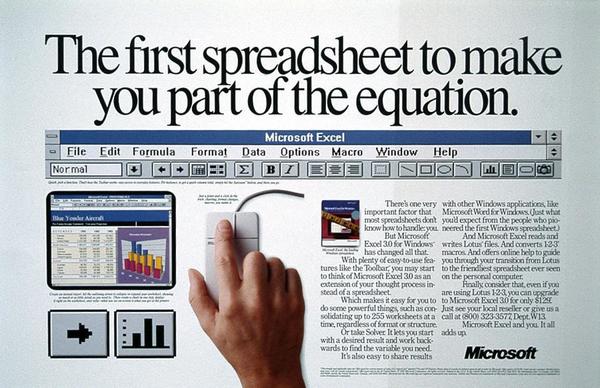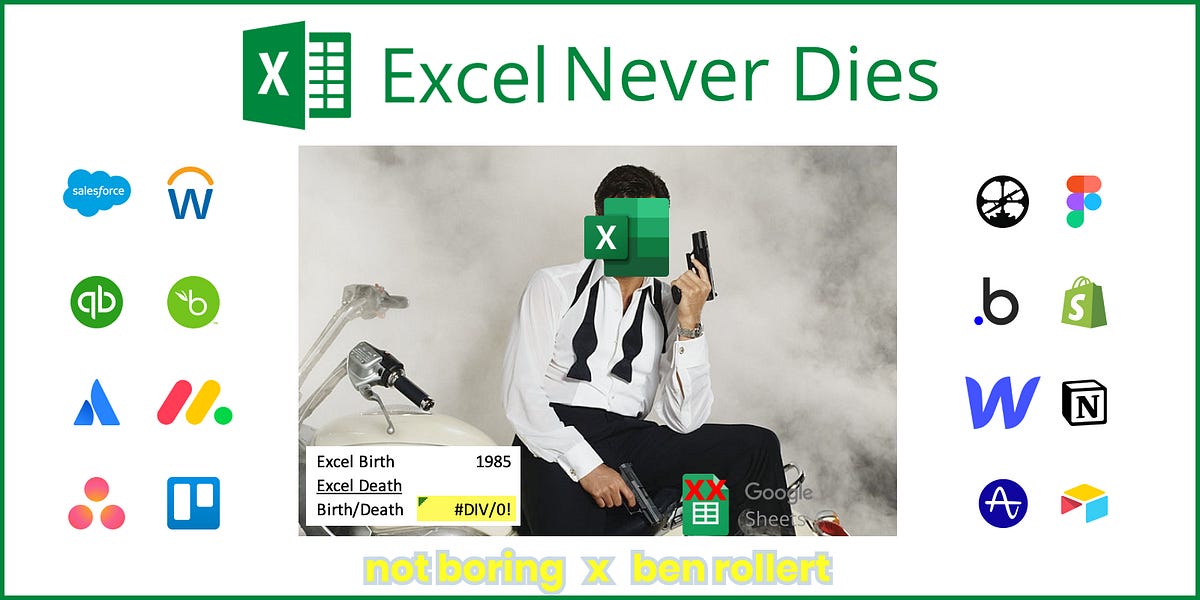One Program to Rule Them All
If you want to see the future of B2B software, look at what Excel users are hacking together in spreadsheets today.

Capital Thinking · Issue #917 · View online
In the popular marketing book Alchemy, Rory Sutherland writes, “A spreadsheet leaves no room for miracles.”We could not disagree more strongly. Most software we use at work exists in one of two categories:
- It’s new and we love it for now.
- It’s old but we have to use it and we hate it.
Excel Never Dies
Packy McCormick | Not Boring Co:
But there’s one software product born in 1985, before many of us were even a twinkle in our parents’ eye, that inhabits its own category: it’s old, but we love it, we always will, and you’ll have to pry it from our cold, dead, fingers. That product, of course, is Microsoft Excel.
Anyone who has worked in finance or consulting grew up on it, learned to love it over thousands of hours of practice and improvement. Whether they realized it or not, they were becoming programmers, or at least no-code practitioners before the no-code movement took off.
“Proficient in the Microsoft Office Suite” is so meaningless that it’s become a meme, but the ability to bend one specific Office program, Excel, to one’s will is a badge of honor. But the enduring, passionate user fervor for the product isn’t even its most unique attribute. Excel’s most lasting impact extends beyond the spreadsheet itself.
Excel may be the most influential software ever built.
It is a canonical example of Steve Job’s bicycle of the mind, endowing its users with computational superpowers normally reserved for professional software engineers.
Armed with those superpowers, users can create fully functional software programs in the form of a humble spreadsheet to solve problems in a seemingly limitless number of domains.
These programs often serve as high-fidelity prototypes of domain specific applications just begging to be brought to market in a more polished form.
If you want to see the future of B2B software, look at what Excel users are hacking together in spreadsheets today.
Excel’s success has inspired the creation of software whose combined enterprise value dwarfs that of Excel alone.There are two main ways Excel has set the broad roadmap for the B2B software industry for decades, and will continue to for years to come:
- The Unbundling of Excel. Hundreds of B2B startups have been built by taking a job currently being done in Excel and trying to accomplish the job in more optimized, purpose-built B2B software. Every time you hear an entrepreneur say, “We’re replacing siloed spreadsheets and outdated processes with purpose-built software,” you’re hearing the Unbundling of Excel in real time. Many popular SaaS applications fall in this category. And yet, despite being “unbundled,” Excel keeps getting stronger.
- Inspired by Excel. That resiliency has inspired entrepreneurs to look more deeply at what makes Excel tick, and why. Adventurous builders are creating new software that doesn’t unbundle Excel, but is Inspired by Excel. Excel’s balance of usability and flexibility can be found in popular no-code and low-code products created over three decades since Excel first graced the screen. This source of inspiration is less direct and more meta; it is less about recreating anything concrete that happens in Excel, and more about capturing the essence of what makes Excel so successful.
We love Excel, everyone reading this probably loves Excel, and still, its impact is deeply under-appreciated. Today, we’re going to fully appreciate it by covering:
- The History of Excel
- Excel as a Language
- The Lindy Effect
- Excel’s Limitations
- No-Code and the Unbundling of Excel
- Why Excel Will Never Die
A little competition isn’t new to Excel. It was born fighting.

*Feature post photo credit: Microsoft Excel
